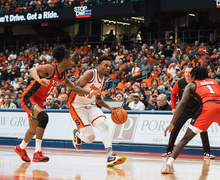Panel discusses activism as essential part of academics
Yusuf Abdul-Qadir and Josh Bransky, an engagement fellow at SU, and a freshman architecture major, respectively, participate in Wednesday nights first-ever White House Young America Series, The event took place in Joyce Hergenhan Auditorium from 6-9 p.m.
When it comes to solving the critical issues that face the United States, community involvement is not better than education, said Marion Wilson, associate professor in the College of Visual and Performing Arts.
‘Activity is not better than academics; it’s core to academics,’ Wilson said. ‘What we’re doing is academics.’
Wilson was part of a seven-person panel that discussed how collaboration could solve the issues of inclusive urban education and environmental sustainability in the first-ever ‘White House Young America Series,’ held Wednesday at Syracuse University.
The event, which took place from 6-9 p.m. in the Joyce Hergenhan Auditorium, featured presentations by White House officials, SU and Cornell University students, and open-format dialogue.
Chancellor Nancy Cantor and high-ranked SU administrators such as Thomas Wolfe, senior vice president and dean of student affairs, were in attendance.
Toward the beginning of the event, Azhar Ali, junior education major at SU, discussed the challenge of defining inclusive urban education and said it differs for each individual. He also contended that students have an obligation to address this problem in the community.
‘A lot of the students I spoke to were really apathetic and were more or less indifferent and had this defeated attitude toward promoting inclusivity,’ Ali said. ‘I feel like we have this responsibility as students to want to promote inclusivity, to be inclusive and to understand our peers.’
After a spoken-word performance, Jeremy Blum, a senior at Cornell, discussed the importance of information in promoting sustainability.
Blum discussed his involvement with sustainability organizations at Cornell. He suggested measures, such as a meter, to show how wasteful consumption results in higher electricity bills and said this could help curtail the problem.
But while the topics of inclusive urban education and sustainability guided the event, it also stressed the importance of open dialogue and collaborative community action.
Victoria McCullough, assistant to the director of the White House Office of Public Engagement, and Samuel Ryan, regional and youth outreach associate for the U.S. Department of Education, fielded questions and facilitated discussion from audience members.
Attendees expressed concerns about the continued reliance on oil in society, unequal per-pupil expenditures and the declining quality of U.S. public schools compared to the rest of the world.
Like many of the other event hosts, McCullough assured members of the audience their voice would be heard.
‘Your ideas, your suggestions will really inform the policies that we’re trying to make,’ McCullough said. ‘I can guarantee that what you say here really informs and shapes what we’re doing back in Washington.’
The event concluded with a panel showcasing the efforts of individuals in the community that have achieved this kind of change.
Nida Nizam, a senior at McGill University and moderator of the panel, said she hoped this would inspire attendees to get involved in the movement.
‘Hopefully there have been some examples that give you ideas for ways that we can apply all our talent, passion or interests into tangible results and change for your community,’ Nizam said. ‘Everybody’s waiting for each other. Get moving. Make some friends. And start making change.’
SU students who attended the event had mixed thoughts.
Rachel Mandel, a freshman psychology major, said she enjoyed the event but thought it could have been more structured. She did, however, enjoy the discussions that involved students.
‘Overall, it was a good experience,’ she said. ‘It was definitely interesting, though there was room for improvement.’
Dylan Sodaro, a junior international relations, Middle Eastern studies and policy studies major, agreed. He said he wished the event had showcased the efforts of the youth in Syracuse more.
‘For a slight period of time, it turned more into a public forum town hall meeting,’ Sodaro said. ‘But that panel at the end I enjoyed the most, to hear from the people and what they were doing.’
Published on April 19, 2012 at 12:00 pm
Contact Dylan: dmsegelb@syr.edu | @dylan_segelbaum





